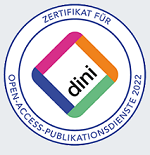Eldorado - Repository of the TU Dortmund
Resources for and from Research, Teaching and Studying
This is the institutional repository of the TU Dortmund. Ressources for Research, Study and Teaching are archived and made publicly available.

Communities in Eldorado
Select a community to browse its collections.
Recent Submissions
Amtliche Mitteilungen der Technischen Universität Dortmund Nr.40/2025
(Technische Universität Dortmund, 2025-12-18)
3D-printed open-source sensor flow cells for microfluidic temperature, electrical conductivity, and pH value determination
(2024-02-28) Dinter, Robin; Helwes, Lennart; de Vries, Stijn; Jegatheeswaran, Kausik; Jibben, Henning; Kockmann, Norbert
Due to the miniaturization of equipment for flow chemistry and microprocess engineering, low-cost sensors and analytical devices are becoming increasingly important for automated inline process control and monitoring. The combination of 3D printing technology and open-source lab automation facilitates the creation of a microfluidic toolbox containing tailored actuators and sensors for flow chemistry, enabling a flexible and adaptable design and efficient processing and control based on the measured data. This contribution presents a set of 3D-printed microfluidic sensor flow cells for inline measurement of temperature, electrical conductivity (EC), and pH value, while compensating for the temperature dependence of EC and pH. The tailored sensor flow cells were tested using model reactions in a single-phase capillary flow system. They have an accuracy comparable to reference sensors in batch measurements. The sensor data can be used to monitor the reaction progress (conversion), determine the kinetic data (activation energy, pre-exponential factors) of saponification reactions, and identify titration characteristics (equivalence and isoelectric points) of neutralization reactions. Hence, the 3D-printed microfluidic sensor flow cells offer an attractive alternative to commercial analytical flow devices for open-source and low-cost lab automation.
Media use among children with ASD: perspectives and concerns of parents
(2025-10-13) Pliska, Larissa; Kunina-Habenicht, Olga; Ritterfeld, Ute
Digital media is a significant part of daily life for both adults and children, raising concerns among parents about its impact on child development, particularly for those with autism spectrum disorder (ASD). This study explores the differing perspectives and concerns of parents with and without ASD regarding their children’s media use. A total of 117 parents of children with ASD and 58 parents of typically developing (TD) children participated in an online survey. The study employed group comparisons, correlations, and hierarchical regressions. Results show that parents of children with ASD expressed greater concern about media use compared to TD parents, especially regarding potential negative effects on health and behavior. However, these concerns did not extend to child development or intensification of ASD symptoms. Key predictors of parental concern included challenges in limiting media use, perceptions of media preference and addiction, and children’s ability to cope without media. While parents of children with ASD have notable concerns about media use, these are not excessively pronounced compared to TD parents. Many report allowing digital media as a means for self-regulation in their children. Future research should also examine positive aspects of digital media usage as potential influencing factors.
Rechenstörungen im Grundschulalter
(2025) Lamb, Sarah; Kuhn, Jörg-Tobias; Brandenburg, Janin
Kinder mit einer Rechenstörung sollten frühzeitig identifiziert und in ihren mathematikspezifischen Fertigkeiten gefördert werden, um einen persistierenden Entwicklungsverlauf zu verhindern. Die Hauptverantwortung für diese Aufgabe liegt in erster Linie bei den Bildungsinstitutionen, insbesondere der Schule und damit bei den Lehrkräften. Die kumulative Dissertation untersucht, wie Lehrkräfte Grundschulkinder mit Anzeichen einer Rechenstörung frühzeitig identifizieren können. Studie I untersuchte, ob die Defizite in den basisnumerischen Fertigkeiten von Kindern mit einer Rechenstörung eher auf eine Entwicklungsverzögerung oder auf eine rechenstörungsspezifische qualitative Abweichung hindeuten und, ob diese Defizite auf eine (selektive) Beeinträchtigung in einem der zentralen Kernsysteme der Zahlenverarbeitung zurückzuführen sind. Dazu wurden die basisnumerischen Fertigkeiten von N = 480 Kindern (n = 68 Kinder mit Rechenstörung, Klassenstufe zwei bis vier) untersucht. Die Ergebnisse der Multilevel-Analysen sprechen eher für eine Entwicklungsverzögerung infolge eines Defizits in der approximativen Mengenverarbeitung. Daran anschließend wurde in Studie II ein theoriebasierter Screeningfragebogen für Lehrkräfte vorgestellt und hinsichtlich seiner psychometrischen Eigenschaften untersucht. Hierfür wurden die Daten von N = 377 Schüler*innen (n = 45 Kinder mit Anzeichen für eine Rechenstörung) der Klassenstufe zwei bis vier und N = 33 Lehrkräften erfasst. Die Ergebnisse belegen, dass der Fragebogen über gute bis zufriedenstellende Screeningeigenschaften verfügt und Kinder mit testdiagnostischen Anzeichen für eine Rechenstörung ökonomisch, reliabel und valide identifiziert. Studie III (Datenbasis Studie II) untersuchte, welche mathematikspezifischen und -unspezifischen Schüler*innenmerkmale die Lehrkräfteeinschätzung im Screeningfragebogen beeinflussen und ob es Variationen zwischen den Lehrkräften gibt. Multilevel-Analysen zeigen, dass die Einschätzungen der Lehrkräfte im Screening vorrangig durch die mathematische Leistung der Schüler*innen bestimmt werden. Allerdings bestehen Unterschiede in der Urteilsstrenge zwischen den Lehrkräften. Insgesamt bieten die Ergebnisse dieser Dissertation praxis- und forschungsrelevante Implikationen, die die Früherkennung von Kindern mit einer Rechenstörung im schulischen Kontext unterstützen. Dennoch besteht weiterhin Optimierungsbedarf, um die frühzeitige Risikoidentifikation von Kindern mit einer Rechenstörung zu verbessern.
Amtliche Mitteilungen der Technischen Universität Dortmund Nr. 39/2025
(Technische Universität Dortmund, 2025-12-17)
